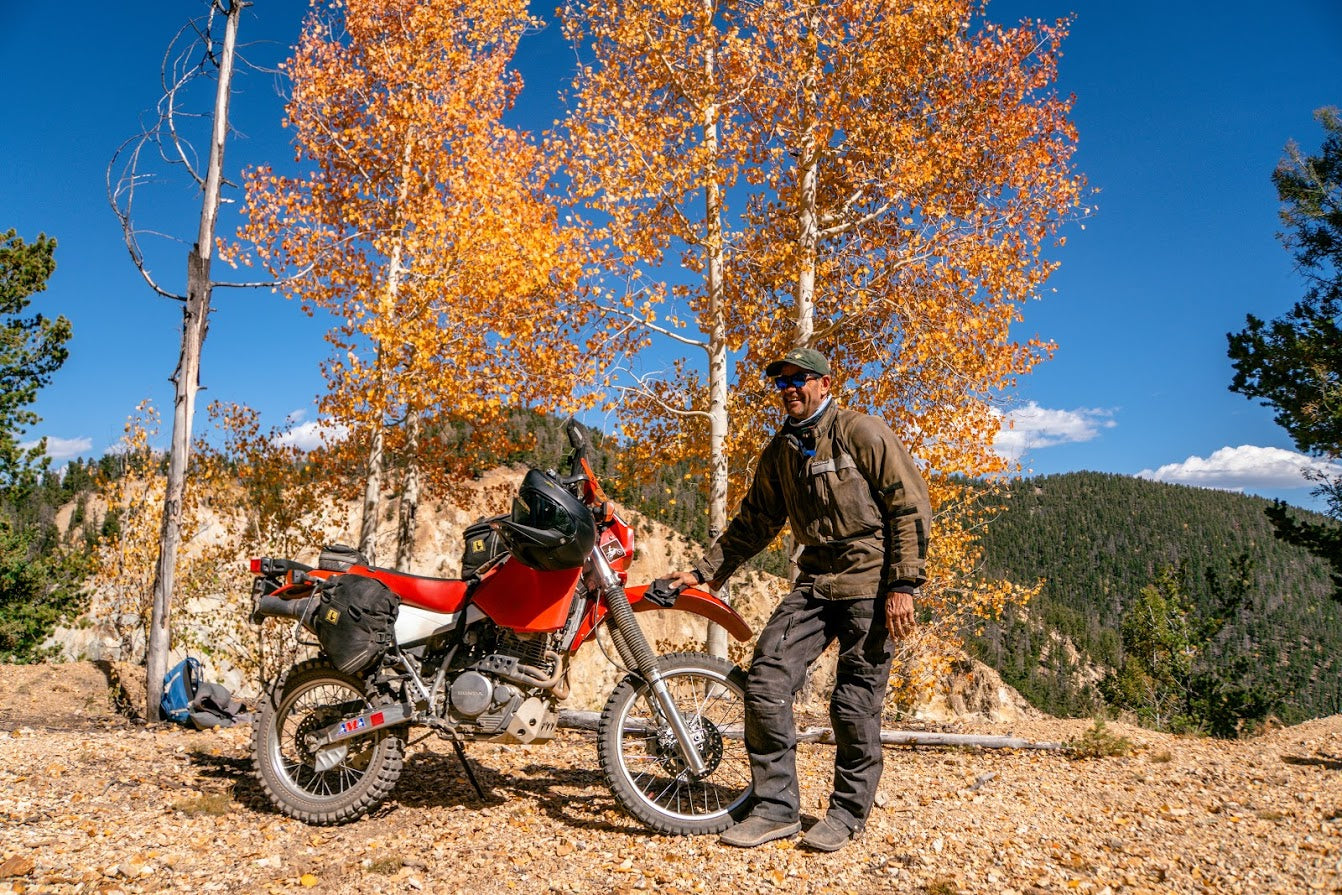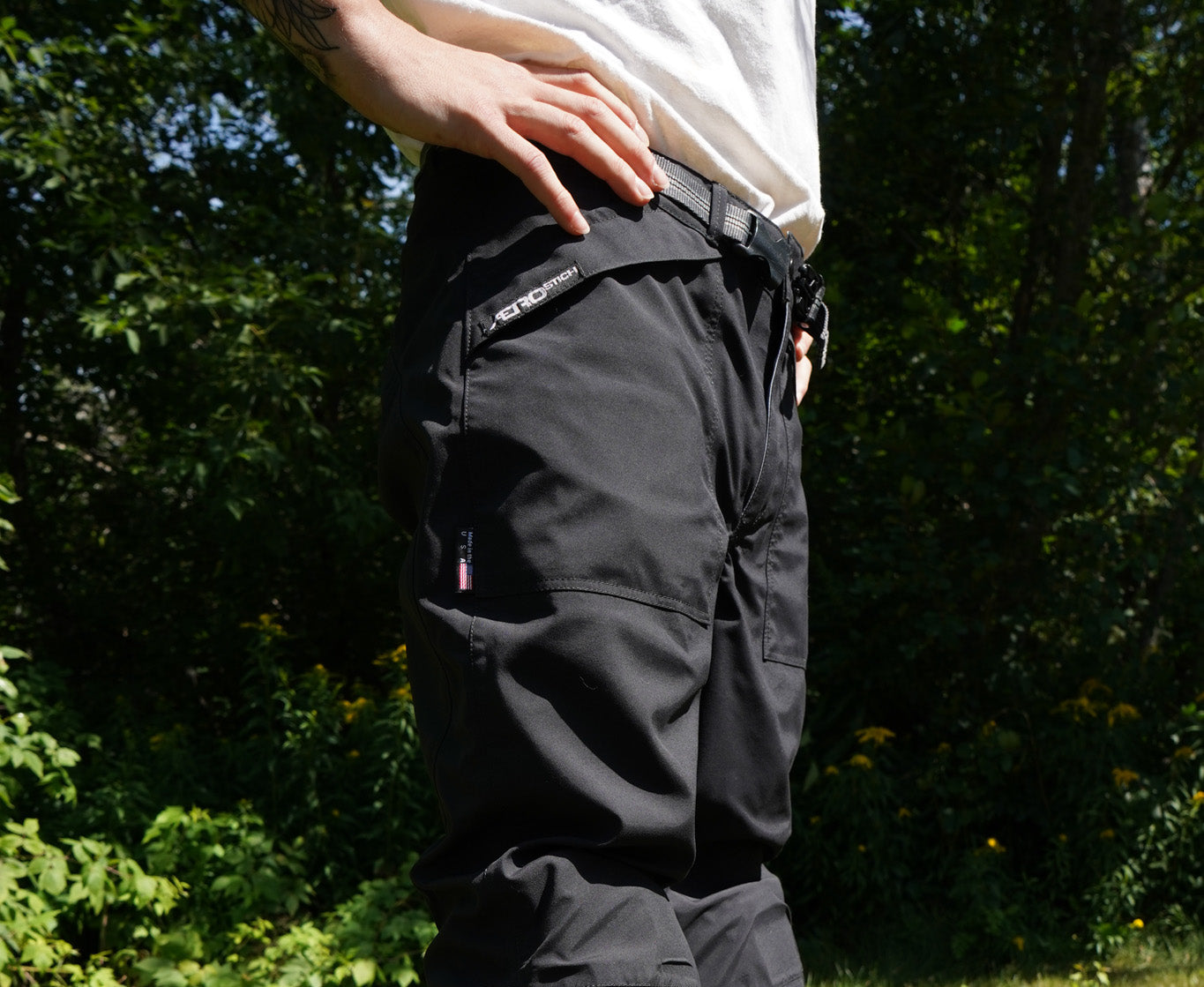Our Irrational Attachments
Many years ago I read a story in a British motorcycle magazine about a fellow who’d ridden the same bike for almost his entire life. A quintessential quirky Englishman. I liked this story so much that I transcribed and saved it back in 2002, because at that time I didn’t have easy access to a digital scanner. It was an incredible story…Some fellow had bought a new bike in 1929 and then ridden it continuously and as his only transportation for the next 70 years until he died. Sometimes Aerostich customers -- and some motorcyclists-in-general – form long attachments to their gear and motorcycles, but nothing like this.
Perhaps today it is textbook-simple for any modern psychologist to explain this kind of long-term loyalty toward things inanimate which have been wonderfully ‘faithful’? Emotional transference? Or? Whatever the explanation, an understanding appreciation doesn’t actually change one’s situation. I can sort of trace threads of my own such irrationality as perhaps descending from a few long-ago (and long forgotten) childhood experiences, but any limited self-awareness here does not salve or mitigate these materialistically-anthropomorphizing behaviors.
There are dozens of examples of faithful artifacts from my life for which I’ve developed some kind of irrational attachment, particularly my long-used gear, motorcycles and tools. Examples surround me and range from an old practically worthless aluminum snow shovel which has been repaired and ‘rebuilt’ several times simply because I like how it ‘feels’, to long-faithful motorcycles, tools and related gear. (About that shovel…For maybe thirty five years I’ve removed winter’s snow with that stupid thing. Duluth averages about 85” a year x 30-plus years with this shovel = who cares?...it’s moved a lot of snow. Back when I was a kid I hated to shovel, doing so at least once by parental command: “Get out there and shovel! Right now!”, and yet today I’m lovingly maintaining a stupid old shovel…) I know others who can only cook their family’s meals on their beat-up rickety worn-out kitchen stove surrounded by an otherwise beautifully remodeled and modernized kitchen, and others who are cooking-fluent only with some familiar and beat-up old cast iron pan.
 |
 |
 |
No parental memories were in any way ever involved with my motorcycling, as neither parent rode and both were neutral on this activity, but to this day I sure love ‘dancing’ with the familiar crappy old bikes I’ve long ridden and maintained. Whether this dance involves old motorbikes, gear, kitchen stoves, fry pans or whatever, neurologically it probably all is about the same as Willie Nelson’s relationship to his famously beat up guitar ‘Trigger’, except in most cases enjoying THC (…weed, marijuana) isn’t quite as connected.
The story excerpted below is thin on psychological speculation about emotional transference (?) or whatever, but still amazing, and indirectly reveals something about why Aerostich gear is made the way it is, and why it may be worth this level of attachment.
We work everyday here to update and improve Aerostich products, but this is not always enough to trigger a replacement purchase from someone with well-worn Aerostich gear. You would hardly believe what we sometimes receive for refurbishment these days. Beloved beat-up old riding gear that’s been long used and cared for. Stuff that remains both comfortable and protective, and a well-experienced rider’s faithful tool…A faithful and silent witness to years of motorcycling experiences.
“But the newest Aerostich gear is WAY better.” We say.
“Bah, just do the best you can to fix up this one..” They reply.
And so we usually do.
Long Service Model
Excerpted From ‘The Classic Motorcycle’ (UK), February 2002; by Roy Poynting http://www.classicmotorcycle.co.uk
“Bill Shepherd bought his James brand new in 1929. It proved a shrewd purchase as it served as his main transport for the rest of his life. Roy Poynting samples this fully documented, original and unrestored vintage two-stroke.”
“….I guess we all keep some paperwork about our bikes. If only to look back at, and wonder why we bankrupted ourselves to buy some worthless old hack. But imagine being so satisfied with your purchase that you kept it until your death, and along the way, you kept all the paperwork which went with it.
Bristolian Bill Shepherd was such a man. A life-long bachelor who never drove a car, he was apparently fiercely independent and was reluctant to even accept a lift. In old age he sometimes resorted to public transport, but otherwise, he went everywhere on two wheels. In 1927, he bought a Rudge Whitworth pedal cycle, and kept its bill of sale among his records. Then in 1929 he went to Tinklin and Daish, motorcycle agents of Cleveland, Bristol, and ordered a Model A9 James. And that was that! The Rudge cycle and the James motorcycle were his sole personal transport for the rest of his life.
It didn’t restrict Bill Shepherd’s activities, though. He thought nothing of taking a week’s holiday and riding the other end of the country to watch the Scottish Six Days Trial! When he had had the James a mere 32 years he proudly wrote to Villers saying how happy he had been with its two-stroke engine. At that time-less than half way through his ownership-it had propelled him over more than 100,000 miles!
But to return to the historical records, Bill Shepherd meticulously kept them all. They begin with an individually typed letter from Tinklin and Daish-dated 25/6/29, and signed by Mr. Daish-stating that: ‘we beg to inform you that we have placed an order and hope to be able to notify you of its delivery in the course of a week or so.’ The delivery date was slightly optimistic, but on 15/7/29 Mr. Daish wrote that: ‘We beg to inform you that we now have had delivery of your James motorcycle...We shall be pleased to see you at any time that is convenient to you.’
Bill duly took delivery-he even kept the guarantee card which had been dangling from the handlebars - and registered his purchase with the manufacturers. On the 1st of August, the James Cycle Company sent a typewritten personal acknowledgement promising: ‘Should you at anytime require information, or other assistance, our Services Department will always give you prompt and careful attentions’. How sad that we have abandoned such leisurely courtesy in just one man’s lifetime.”
“…I can’t deny that mixing oil with the petrol tends to produce an exhaust haze, but if he’d wanted to Bill Shepherd could have forked out another two quid for Villier’s sophisticated automatic lubrication set-up. Speaking from experience, I think he was wise to opt for the less temperamental petrol system. Anyway, smoke is not a great problem with modern oils, and they have all but eliminated the old two-stroke bugbears of coking up and plug-whiskering.”
“…The lighting system is undeniably pathetic. Six-volts and very few watts - direct from the flywheel are shared between a dim 4 volt headlamp bulb in series with an almost invisible 2 volt tail lamp. But otherwise, comparison of the James A9 with a rigid 200cc James from the early Fifties, leads to the inevitable conclusion that our engine and frame manufacturers had been marking time for a quarter of a century.
Bill Shepherd would not have been human if he had never considered changing to another motorcycle. But such thoughts would have soon evaporated, because he obviously belonged to the ‘if it ain’t broke, don’t fix it’ school. He added a few items to the basic specification on purchase. The carrier was a factory option costing eight schillings and sixpence (42 1/2 p), and the fork dampers were quite an upmarket feature at 18/6 (92 1/2 p) extra. Thereafter, changes to the James’s original specification are few and far between. Notably the silencers are not the originals. Again, speaking from experience with my own James, he may have changed to ones which ere more easily decarbonised. He also swapped the lever throttle control for a twistgrip. Bill apparently initially spurned the factory option of a factory-fitted lighting set (three versions were offered at prices ranging from £1 10s to £5), but within a couple of years he fitted an aftermarket set made by Miller.
For the next 60-plus years, Bill Shepherd confined himself to essential maintenance. The original instruction book and spares list are among the documents, and make their own contribution to the historical records. For one thing, they are devoid of the filthy fingerprints that point to the unskilled tinkerer. Equally tellingly, the few items neatly underlined in the spares list show that the only cycle parts he needed were cup and cone bearings for the steering head and the wheels.
When Bill Shepherd wrote to Villiers in 1961, he owned up to replacement of a few engine parts. Four sets of small end bushes, piston rings and gudgeon pin end plugs, together with one gudgeon pin and a couple of carburetor needles was the sum total. It was a pretty modest list by anybody’s standards, and at that time he estimated that the James had cost him a penny-farthing (1/2p) per mile to run. Villiers were delighted with the story, and ensured that it ran in both the weekly magazines in May that year.
Reliability and economy, what more could somebody obviously unconcerned with speed or status want? And the James continued to deliver more of the same. Amazingly, even today, the James is still on its original bore, and only those gudgeon pin end plugs have needed replacement...again.
I’ve heard of other cases where a motorcycle remained in the same ownership for many years, but I’ve never come across a story like Bill Shepherd’s. It bears repeating that for nearly 70 years, the James was his only mechanized transport! Not a family heirloom, not a sentimental relic, not a toy, but an actual working motorcycle. And what makes Mr. Shepherd even more unusual is that while he was still running his old motorcycle because of its reliability and economy, he also realized its historical significance. Bill was an early member of the Bristol Section the Vintage Club; and while others were restoring Big Ports and V-twins for Sunday best, he was actually riding his vintage James day in and day out.
As he approached the end of his long life, Bill Shepherd wondered what to do with his unique motorcycle. It would have been unthinkable to entomb it in a museum, or sell it to somebody who would change or not appreciate it. The answer was close at hand. His friends in the Bristol VMCC knew and revered the machine, and Bill simply left it to them in his will so that it would continue to be used in the proper way. He also left them the Rudge cycle, which he kept equally roadworthy and original.
So far, six members of the Bristol Section have ridden the James, and it is now in the guardianship of retired electronic mechanic Trevor Wells.”
“…Apart from have the unrecognizably scruffy tank re-painted, Section members have done little to the uncomplaining little workhorse, other than pile yet more miles onto a total which must now exceed 150,000!
On their advertising material and tank badges, the Birmingham company immodestly referred to their products as the ‘The Famous James’. Sometimes that was a bit far fetched, but if ever a James deserved the adjective, this is the one.”




















Really liked the post regarding irrational attachments. I’ve been driving the same car for 22 years, many of my tools date back to high school. I have finally come to the conclusion that I should only acquire GOOD STUFF, because i’m generally stuck for the duration with whatever crosses my path.
Leave a comment